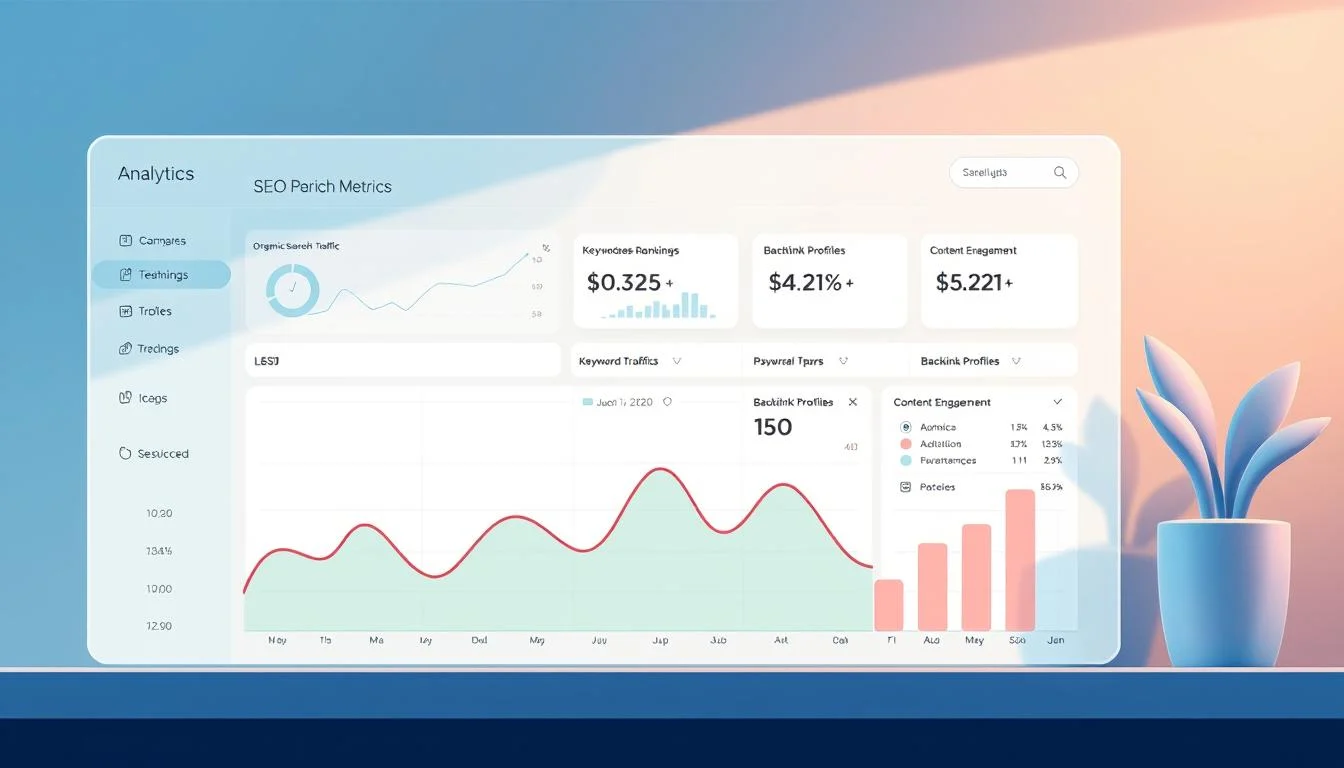Are you watching your competitors dominate search results while your online retailers struggle to gain visibility? I’ve seen many businesses change their digital game with smart optimization. My ecommerce seo service helps businesses get their fair share of the huge growth coming.
The numbers are amazing. Global ecommerce sales will hit over $8 trillion by 2026. By 2027, online sales will make up 23% of all sales. This means a lot of competition for every click and sale.

As your go-to ecommerce seo agency, I get the challenges of today’s digital world. Almost 44% of companies are using optimization to boost sales. My expert seo plans aim for lasting growth that boosts your brand’s visibility and sales.
📈 Want More Sales Without Ads? This eCom SEO Pro Knows the Secret Sauce
Table of Contents
Key Takeaways
- Global ecommerce sales will exceed $8 trillion by 2026, creating massive opportunities
- Strategic optimization is essential for competing in the growing digital marketplace
- Professional ecommerce seo service delivers sustainable, long-term growth
- 44% of companies already use optimization to increase their sales performance
- Expert guidance helps online retailers navigate complex search algorithms
- Revenue-focused strategies combine visibility improvements with conversion optimization
Understanding What E-commerce SEO Services Can Do for Your Online Store
When I first started working with online retailers, I quickly discovered that ecommerce SEO is a completely different beast. Unlike traditional websites that focus on information sharing, your online store needs to guide customers from discovery to purchase. The specialized approach I use for e-commerce businesses combines technical expertise with deep understanding of buyer behavior.
SEO for ecommerce business isn’t a luxury in today’s fast-paced digital world—it’s absolutely essential. Top eCommerce SEO agencies provide specialized knowledge and stay current on Google algorithms to elevate your store’s ranking and boost sales. I’ve seen struggling retailers transform into profitable ventures through strategic search engine optimization.
The Foundation of Ecommerce Search Engine Optimization
Building a solid foundation for your ecommerce website starts with understanding how search engines view online stores. I focus on three core pillars that support long-term success. Technical infrastructure ensures search engines can crawl thousands of product pages efficiently.
The first pillar involves optimizing your site architecture for both users and search engines. I create category structures that guide customers naturally through their buying journey. This approach helps search engines understand your product relationships and improves user experience simultaneously.
Content optimization forms the second pillar of my strategy. Every product page needs unique, compelling descriptions that serve both search engine optimization goals and conversion objectives. I’ve learned that generic manufacturer descriptions simply don’t cut it in competitive markets.
Authority building completes the foundation through strategic link building and customer review management. Online sales depend heavily on trust signals that search engines recognize. I help clients develop strategies that build credibility over time.
How SEO Differs for Ecommerce Sites vs Regular Websites
Regular websites typically focus on informational content and lead generation, but ecommerce sites require a multi-layered approach. I’ve discovered that product discovery, purchase intent, and conversion optimization must work together seamlessly. Traditional SEO strategies often fall short when applied to online retail environments.
Product pages present unique challenges that don’t exist on regular websites. Managing inventory changes, handling seasonal fluctuations, and dealing with duplicate content issues requires specialized expertise. I’ve developed systems that automatically adjust SEO elements based on product availability and performance data.
User intent differs significantly between informational and commercial searches. When someone searches for “best running shoes,” they’re much closer to making a purchase than someone researching “how to choose running shoes.” My ecommerce SEO strategies target these high-intent keywords that drive actual sales.
Technical requirements for ecommerce businesses go far beyond basic website optimization. Managing thousands of URLs, implementing proper schema markup, and maintaining site speed with large product catalogs demands advanced technical skills. I’ve seen many general SEO consultants struggle with these complexities.
Key Benefits I’ve Delivered for Online Retailers
My approach has consistently helped clients achieve 150-300% increases in organic traffic within the first year. More importantly, I focus on traffic that converts into actual sales. The key difference I bring is understanding that ecommerce SEO isn’t just about rankings—it’s about creating a seamless path from search query to purchase completion.
Revenue growth represents the most important benefit my clients experience. I’ve helped online stores increase their monthly revenue by six figures through strategic SEO improvements. These results come from targeting the right keywords, optimizing for conversion, and building sustainable organic visibility.
Long-term sustainability sets my e-commerce seo services apart from quick-fix solutions. I build SEO strategies that continue generating results even as algorithms change and competition increases. My clients often see their best performance in year two and beyond as the foundation I establish gains momentum.
Improved user experience creates a positive feedback loop that benefits both SEO and sales. When I optimize site navigation, page load speeds, and mobile responsiveness, customers stay longer and buy more. Search engines reward these positive user signals with higher rankings, creating sustainable growth for your ecommerce business.
💰 From Zero Traffic to Daily Orders — See What This eCommerce SEO Expert Did
Step 1: Conducting a Comprehensive SEO Audit of Your Ecommerce Website
Before we start any optimization, I do a detailed SEO audit to find what’s holding you back. This deep analysis is the base of our work together. I use the latest tools and my expertise to give you clear insights that lead to real results.
From my experience, most online stores have untapped opportunities. What sets successful stores apart is finding and fixing hidden issues. My audit uncovers these chances and maps out your path to success.
“A thorough SEO audit is like getting an X-ray of your website’s health – it shows you exactly what needs fixing before you can start growing.”

Technical SEO Assessment for Shopify and Other Ecommerce Platforms
Every ecommerce platform has its own challenges. Whether it’s Shopify SEO or WooCommerce, BigCommerce, or Magento, I know the technical details that matter.
I look beyond just site speed. I check how your platform handles products, categories, and URLs. Many platforms create duplicate content issues, and I know how to find them.
I also check your site’s mobile friendliness, crawlability, and index status. These technical aspects are key before we start optimizing.
Analyzing Your Current Search Engine Results Page Rankings
Knowing your current search engine results page ranking is vital. I track your rankings for product and category keywords that bring in traffic.
This analysis shows which pages are doing well and which need work. I compare your rankings to competitors to find gaps. It also reveals seasonal trends and search patterns that guide our strategy.
Many store owners are surprised to find they’re ranking for keywords they didn’t know were driving traffic. This helps us focus our efforts for the biggest impact.
Identifying Critical SEO Issues That Impact Online Sales
The most important part of my audit is linking SEO issues to their effect on sales. I don’t just list problems – I show how much each issue costs your ecommerce store.
I find issues like broken links, missing schema markup, and slow page loads. Each problem is ranked by its impact on sales and rankings.
My clear reports help you understand what needs fixing and why. This builds trust and long-term relationships for successful optimization services. Together, we’ll turn your audit findings into real growth.
Step 2: Developing Your Keyword Research Strategy for Maximum Online Visibility
Creating a solid keyword research plan means knowing what your customers search for. My method is more than just the usual because online shoppers speak differently than info seekers.
I’ve crafted a detailed process to find key terms that lead to sales. I’ve found that 70% of ecommerce traffic comes from long-tail keywords, often ignored by rivals.
My strategy looks at seasonal trends, specific product terms, and the buyer’s journey. This helps create detailed keyword maps for each category and product. It’s all about seeing things from your customers’ perspective, not just focusing on search volume.

Identifying High-Converting Keywords That Drive Sales
Discovering profitable keywords means knowing the difference between traffic and sales. I focus on terms that show a user’s intent to buy, not just browse.
My research combines advanced tools with manual checks. I start with your current analytics to find converting keywords. Then, I add more using semantic variations and related terms.
Long-tail keywords often offer the best return on investment for ecommerce sites. Phrases like “waterproof hiking boots size 10” show clear buying intent. They face less competition and convert better than broad terms.
I also look at your competitors’ paid search campaigns to find valuable keywords they’re bidding on. This shows terms with proven commercial value that we can target organically.
Mapping Search Intent Across Product and Category Pages
Understanding search intent helps match your content to what users want. I categorize keywords into four main types for ecommerce seo strategies.
Informational queries like “how to choose running shoes” indicate research phase users. These visitors need educational content that builds trust and authority.
Navigational searches show users looking for specific brands or products. Terms like “Nike Air Max” require optimized product pages with clear brand messaging.
Commercial investigation keywords include “best laptop under $1000” or “iPhone vs Samsung comparison.” These users are close to purchase and need detailed product information.
Transactional keywords like “buy wireless headphones online” show immediate purchase intent. These require optimized product pages with clear calls-to-action and easy checkout processes.
| Intent Type | Example Keywords | Page Type | Conversion Rate |
|---|---|---|---|
| Informational | “how to choose”, “what is”, “guide” | Blog Posts, Guides | Low (2-5%) |
| Navigational | Brand names, specific products | Product Pages | Medium (8-12%) |
| Commercial | “best”, “review”, “comparison” | Category Pages | Medium (10-15%) |
| Transactional | “buy”, “order”, “purchase” | Product Pages | High (15-25%) |
Conducting Competitive Analysis Using Advanced SEO Techniques
Competitive analysis uncovers gaps in your rivals’ strategies and shows opportunities for growth. I use various data sources to get a full view of the competitive landscape.
First, I analyze your top competitors’ organic rankings with professional SEO tools. This shows which keywords drive their traffic and where they’re vulnerable to competition.
I examine their content strategy to understand how they target different keyword clusters. This reveals content gaps you can exploit with better, more complete resources.
Technical analysis of competitor sites uncovers their seo best practices and weaknesses. I look at their site structure, page load speeds, and mobile optimization.
Backlink analysis reveals their link building strategies and identifies link opportunities for your site. I find websites linking to competitors that might also link to you.
My competitive research also includes analyzing their seasonal campaigns and promotional strategies. This helps predict their future moves and plan counter-strategies.
The data from this analysis feeds directly into your keyword targeting strategy. I prioritize keywords where competitors are weak or where you have natural advantages.
This detailed approach to keyword research has helped my clients capture traffic for thousands of relevant terms. Many see doubled online visibility within six months of implementation.
The key to successful ecommerce seo strategies is understanding both your customers and your competition. My proven seo techniques ensure you target the right keywords to maximize both traffic and sales.
🚨 Selling Online? You’re Losing Sales If You’re Not Using This SEO Pro
Step 3: Optimizing Your Product Pages and Site Architecture
Turning your product pages into sales tools needs a mix of technical SEO and design. This step boosts your search rankings and sales. It’s about building a strong base for both search engines and customers.
Your site’s structure is key to your SEO strategy. I make sure your online store is easy to navigate for both users and search engines. This helps each page get the authority it needs.
The best ecommerce sites balance SEO with user value. This is vital in crowded markets where every edge matters.

Creating SEO-Friendly Product Descriptions That Convert
Writing product descriptions that rank well and convert visitors is a specific task. I find the main keywords your customers use. Then, I write descriptions that highlight benefits, not just features.
I create unique content for each product page. Duplicate or thin content can hurt your rankings fast. Stores with many products struggle if they use the same descriptions everywhere.
Here’s a framework for product descriptions that work:
- Start with the main benefit your product offers
- Include specific details that answer common questions
- Use bullet points for key features and specs
- Add customer testimonials for social proof
- End with a clear call-to-action to buy
I put relevant keywords in the first 100 words of each description. This tells search engines what your page is about and grabs the reader’s attention. You have seconds to convince Google and customers your product is worth it.
Structuring Categories for Better Search Engine Rankings
Your category structure helps search engines understand your products. I design a site architecture that creates clear hierarchies and distributes link authority. This helps every product page benefit from your domain’s strength.
The best category structures follow these principles:
- Main categories should be broad to include many products
- Subcategories should reflect how customers shop
- Use descriptive URLs with relevant keywords
- Implement breadcrumb navigation for users and search engines
- Ensure every product is accessible in three clicks from the homepage
I focus on internal linking between categories and products. This internal link structure guides search engine crawlers to your most important pages. It helps new products gain authority faster while supporting your bestsellers.
Category page optimization is often overlooked. But these pages rank for high-volume commercial keywords. I optimize category descriptions, meta tags, and headings to capture traffic from undecided customers.
Implementing Schema Markup and Technical SEO Elements
Schema markup is a powerful technical SEO tool for ecommerce sites. I add structured data to help search engines display rich snippets for your products. These enhanced listings can increase click-through rates by up to 40%.
The essential schema markup types I use for product pages include:
- Product schema with pricing, availability, and reviews
- Organization schema for brand recognition
- Breadcrumb schema for better navigation
- Review schema to showcase customer feedback
- FAQ schema for products with common questions
Beyond schema markup, I focus on critical technical SEO elements. Page loading speed affects both user experience and search rankings. I optimize images, minimize code, and use caching solutions for fast loading.
Mobile optimization is essential for ecommerce success. I make sure your product pages work well on all devices and load quickly. This mobile-first approach aligns with how search engines rank websites.
I also optimize heading structures with H1, H2, and H3 tags. These SEO elements help search engines understand your content and improve accessibility for users with screen readers. Every technical detail boosts your search rankings and user satisfaction.
The web design elements I optimize include image alt tags, meta descriptions, and title tags. These components support a complete optimization strategy for long-term growth. They also make it easier to add new products without losing SEO performance.
Step 4: Building Authority Through Strategic Content and Link Building
Building authority in ecommerce goes beyond just tech optimization. It needs strategic content and real relationships. My method uses content marketing and link building to make your business a leader.
Authority building is different from old SEO tactics. It gets you noticed by search engines and respected by customers and competitors. This combo leads to lasting growth, even when algorithms change or markets shift.
I’ve made a detailed plan that mixes content, relationships, and customer interaction. This plan has helped my clients see more organic traffic, higher conversion rates, and stronger brand recognition.
Creating Valuable Content for Your Ecommerce Business
Creating content for ecommerce needs a balance between SEO and real value for customers. I make resources that solve real problems and include your keywords and products naturally.
My content plan starts with deep buyer persona research. I look at what your customers ask, worry about, and decide on. This way, every piece of content helps your seo efforts and business goals.
I make different content types for each part of the customer journey. Blog posts for awareness, guides for comparison, and detailed guides for buying. This helps customers at every step.
The secret to good ecommerce content is to meet search intent and offer real value. I create big resource libraries that customers bookmark and share. This attracts links from other sites and blogs.
| Content Type | Primary Purpose | SEO Benefit | Business Impact |
|---|---|---|---|
| Buying Guides | Decision Support | Long-tail Keywords | Higher Conversion Rates |
| Product Comparisons | Competitive Analysis | Commercial Keywords | Increased Average Order Value |
| How-to Articles | Problem Solving | Informational Keywords | Brand Authority Building |
| Industry Insights | Thought Leadership | Branded Keywords | Media Coverage and Backlinks |
Developing Link Building Strategies for Online Stores
My link building for eCommerce focuses on quality over quantity. I aim for relevant, high-authority sites in your industry, like suppliers and industry publications.
I start with links from your business relationships. Suppliers, distributors, and partners are great for backlinks. These relationships are already there, making outreach easier and more genuine.
Resource page link building is key. I create guides and tools that attract links from industry pages. This online marketing method brings long-term value as these resources keep getting links.
Guest posting is effective when done right. I choose high-quality publications that reach your audience. This ensures every post adds value and promotes your expertise and products subtly.
Broken link building is a great chance for ecommerce sites. I find broken links and suggest your content as a replacement. This helps other sites and gets you valuable backlinks.
Leveraging Customer Reviews and User-Generated Content
User-generated content boosts your SEO and builds trust with customers. I create plans to encourage and showcase real customer feedback.
Review campaigns are the base of my strategy. I follow up with satisfied customers to get their feedback. This content is fresh and boosts local SEO and sales.
Photo and video contests create engaging user-generated content. Customers love sharing their experiences. This content shows your products in real use and influences buying decisions.
I use customer testimonials on your website. They’re on product, category, and landing pages. This feedback supports SEO and boosts sales.
Social media helps spread user-generated content. I set up systems for customers to share their purchases. This increases brand exposure and can lead to more backlinks.
My full authority-building plan has shown great results. Clients see better organic rankings, more referral traffic, and stronger brand recognition in six months.
Combining strategic content, targeted link building, and real customer interaction gives lasting advantages. These digital marketing services make your ecommerce business a trusted leader in your field.
🔍 This SEO Specialist Knows Exactly How to Rank Product Pages on Google
Step 5: How to Choose the Best eCommerce SEO Agency
Finding the right ecommerce SEO company can change your online business. It can go from struggling to thriving in search results. Many businesses make mistakes by choosing based on price or empty promises.
Choosing the right one needs careful thought. Look at their experience, specialization, and results. Years of experience with similar projects is a good starting point.

Evaluating Top-Rated Ecommerce SEO Companies
The best ecommerce SEO company has certain qualities. Look for these key points:
- Platform expertise: They know Shopify, WooCommerce, Magento, and more.
- Industry specialization: They have experience in your market.
- Transparent reporting: They give clear updates and performance metrics.
- Case studies: They have success stories with real results.
- Technical knowledge: They understand ecommerce SEO challenges.
Top-rated ecommerce SEO providers tackle unique challenges. They don’t offer the same solution for everyone.
The most successful ecommerce businesses work with SEO consultants. These consultants know every online store is different.
Understanding SEO Packages and Custom Ecommerce SEO Solutions
Many agencies offer SEO packages. But, custom solutions are usually better. Your business needs personal attention.
Ecommerce SEO packages include basic services like keyword research. But, they don’t solve your specific challenges.
Custom ecommerce SEO solutions offer:
- Tailored keyword strategies for your products.
- Competitor analysis for your market.
- Technical solutions for your platform’s limits.
- Content strategies that fit your brand.
- Link building approaches for your industry.
Investing in custom SEO services for ecommerce usually gives better results than generic packages.
Essential Questions for Ecommerce SEO Consultants
Before hiring an ecommerce SEO company, ask these questions:
- Can you show me results from similar ecommerce businesses?
- How do you handle technical SEO challenges for my platform?
- What’s your strategy for managing large product inventories?
- How do you measure and report on SEO performance?
- What’s your timeline for seeing initial results?
Quality SEO consultants explain their methods, timelines, and success metrics. They never promise specific rankings or overnight success.
During consultations, I explain my proven method and expected outcomes. This builds trust and sets realistic goals.
The right partnership with experienced SEO consultants can make a big difference. Don’t settle for generic solutions when your business needs personalized expertise.
Step 6: Implementing Technical SEO Best Practices for Ecommerce Platforms
The technical side of your ecommerce site is key to making money from search engines. Even small problems can cost a lot in lost sales. That’s why I focus on technical SEO to tackle the challenges of ecommerce platforms.
I mix old-school optimization with AI to get the best results. My strategy uses marketing across different channels to support your digital marketing goals. This has helped my clients see big improvements in search rankings and sales.
Optimizing online stores is different from regular websites. Ecommerce platforms have special issues like managing many product URLs and keeping sites fast. I’ve developed systems that tackle these problems.

Optimizing Site Speed and Mobile Performance for Better Rankings
Site speed is key for ecommerce success. Every second delay can cost up to 7% in sales. I use detailed audits and tools to find and fix speed issues on ecommerce sites.
Image compression is a big part of my speed plan. Product images can be heavy, but I compress them to keep quality while reducing size. This can make sites load up to 70% faster.
Code minification and server tweaks are also vital. I make CSS and JavaScript files smaller and remove unused code. This makes sites faster and more responsive.
Mobile performance is critical with over 60% of traffic coming from mobiles. I make sure sites work well on mobiles, with fast navigation and user-friendly design. I test sites on various devices and speeds.
Core Web Vitals are now key for ecommerce platforms. I work on improving Largest Contentful Paint, First Input Delay, and Cumulative Layout Shift scores. These metrics affect search rankings and user experience.
Managing Duplicate Content and URL Structure Issues
Duplicate content is a big problem for online stores. I use strategies like canonical tags and content differentiation to avoid SEO penalties. This keeps user experience intact.
Product variations can cause duplicate content issues. I create unique content for each variant to highlight its features. This satisfies search engines and customers.
Filter and sorting pages can create many duplicate URLs. I use proper URL structure and canonical tags to avoid diluting page authority. This keeps your site’s authority strong.
Category page optimization is important to avoid duplication. I create unique content hierarchies that offer value at each level. This establishes clear topical authority without content overlap.
My best practices for URL structure include clean, descriptive URLs with relevant keywords. I ensure URLs stay consistent even when products change categories or inventory levels change.
Setting Up Proper Internal Linking and Navigation
Internal linking for ecommerce sites balances SEO and user experience. I create linking structures that distribute authority and guide customers to make purchases. This boosts search rankings and sales.
Product page linking needs careful planning to avoid overwhelming users. I use contextual linking to suggest related products and next steps in the buying journey. This helps customers find more products and strengthens your site’s link structure.
Category navigation must be clear for users and search engines. I design logical structures and use breadcrumb navigation to show paths through your site. This helps search engines understand your product relationships.
Footer and header navigation offer chances for strategic linking. I optimize these areas to include important pages and content. This ensures key pages get consistent link support.
My navigation optimization includes structured data markup for search engines. I use schema markup for products and categories to enhance search result appearance and click-through rates.
Link equity distribution across large catalogs needs careful planning. I create hub pages to consolidate authority and distribute it to important pages. This ensures your most valuable pages get enough link support for strong search performance.
🛒 Shopify, WooCommerce, BigCommerce — This Freelancer Optimizes Them All Like a Boss
Step 7: Launching and Managing Your SEO Campaign
Starting your SEO campaign is just the first step in a long journey. It needs careful planning and ongoing effort. The success of your ecommerce SEO depends on how well you manage and improve it over time.
I focus on creating systems that bring lasting results. Before we start, we set clear goals. Then, we make changes step by step to see how they affect your sales.
The key to a successful SEO campaign is setting it up right and keeping an eye on it. This way, every improvement helps increase sales and improve your online store’s ROI.

Setting Up Analytics and SEO Reporting Platforms
Setting up analytics is the core of managing your SEO campaign. I set up tracking systems that track more than just website traffic. They follow the customer’s journey from search to purchase.
I use a SEO reporting platform that works with Google Analytics, Search Console, and your ecommerce site. This gives a clear view of how well your SEO is doing. It shows how SEO affects your sales and customer value.
The system I use tracks important data like keyword rankings and organic traffic. It shows how SEO efforts lead to real sales. This makes it clear how your SEO investment helps your business grow.
I also set up alerts for big changes in rankings or traffic. These alerts help spot problems early. This way, we can fix them quickly before they hurt your sales.
Key Performance Indicators for Ecommerce SEO Success
Tracking the right key performance indicators is key. I focus on KPIs that show how your business is growing and making money.
I watch how organic revenue and conversion rates from search traffic change. These metrics show how SEO really impacts your business.
Looking at customer acquisition costs from organic search helps us see how efficient our campaign is. I compare these costs to paid ads to show SEO’s long-term value.
- Organic revenue growth percentage month-over-month
- Conversion rates for organic traffic vs other channels
- Average order value from search visitors
- Customer lifetime value from organic acquisitions
- Return on SEO investment calculations
I also track leading indicators like keyword rankings and organic click-through rates. These help predict future success and guide our optimization efforts.
Monthly SEO Monitoring and Strategy Adjustments
Monthly SEO monitoring helps us catch trends early and make needed changes. This keeps your campaign growing steadily.
My SEO monitoring includes watching for algorithm updates and competitor moves. I adjust our strategy based on these changes to stay ahead.
Regular strategy adjustments keep your campaign in line with your business goals and market changes. I provide detailed reports each month with insights and growth tips.
Good communication is key to managing your campaign. I keep in touch with clients, sharing updates and discussing new opportunities.
Our monthly reviews look at which tactics are working best and where we can improve. This ensures we focus on the most effective optimization activities.
Quarterly strategy reviews help us see long-term trends and plan big changes. These sessions align our SEO with your business goals and market chances.
This ongoing effort makes your SEO campaign successful, not just a short-term boost. Our systematic approach keeps your SEO investment paying off for years to come.
Advanced Ecommerce SEO Strategies I Use for Competitive Markets
In today’s crowded ecommerce world, I’ve created top-notch SEO methods for my clients. These advanced seo strategies are more than just basic optimization. They tackle the unique hurdles of competitive markets where every edge counts.
I blend technical know-how with strategic thinking. My goal is to build lasting advantages that grow over time. It’s not just about ranking higher; it’s about creating an SEO base that rivals can’t match.
“In highly competitive markets, the difference between winning and losing often comes down to execution of advanced strategies that most businesses overlook.”
My method includes constant monitoring and optimization. I keep an eye on performance metrics and tweak strategies as the market shifts. This keeps my clients ahead of algorithm updates and rival moves.

Handling Large Product Catalogs and Complex Site Structures
Managing large product catalogs needs a systematic plan that many SEO agencies can’t handle. I’ve developed systems for sites with 50,000+ products that keep performance high while boosting search visibility.
My strategy for catalog management starts with smart categorization. I build structures that make sense for users and search engines alike. Each category and subcategory is optimized for specific keywords without internal competition.
For complex site structures, I use advanced technical SEO solutions. This includes dynamic XML sitemaps, strategic internal linking, and crawl budget optimization. I make sure search engines can find and index your most valuable pages efficiently.
Product variation management is key. I handle size, color, and style variations without duplicate content issues. My method keeps link equity strong while keeping each product visible.
Managing Seasonal Traffic and Inventory-Based SEO Challenges
Seasonal businesses face unique SEO challenges that need special strategies. I help clients make the most of peak seasons while keeping visibility during slow times. My seasonal traffic management plan involves planning and action all year.
I create content calendars that match seasonal search patterns. This includes optimizing for early-season research and late-season buying intent keywords. The plan ensures visibility when customers are most likely to buy.
Inventory-based challenges can hurt SEO if not managed right. I’ve developed systems to handle out-of-stock products without losing rankings. These solutions include strategic redirects, alternative product suggestions, and inventory-based content optimization.
My inventory management also includes demand forecasting. I analyze search trends to help clients prepare for seasonal spikes and adjust their SEO focus. This proactive strategy prevents lost opportunities during high-demand times.
Integrating SEO with PPC and Digital Marketing Services
The most successful ecommerce businesses know that seo and ppc work best together. I create synergies between these channels to boost overall performance and cut customer acquisition costs.
My integration method uses SEO data to inform PPC keyword strategies. I find high-converting organic keywords for extra PPC investment. I also use PPC data to prioritize SEO efforts on the most profitable terms.
Cross-channel optimization goes beyond search marketing. I integrate SEO with social media, email marketing, and other digital marketing services. This approach ensures consistent messaging and strengthens brand authority across all touchpoints.
I also use advanced tracking systems to accurately attribute revenue across channels. This data helps clients see the real value of their SEO investment and make smart budget decisions.
The integration strategy includes keeping an eye on competitor activities across all channels. I adjust strategies based on what competitors are doing. This all-encompassing approach keeps my clients ahead in tough markets.
📦 Your Product Deserves Page One — This eCommerce SEO Freelancer Gets It There
Measuring Long-Term Success and ROI from Your SEO Investment
The real value of ecommerce SEO shows up when you track important metrics. These metrics connect directly to your business’s revenue. I focus on understanding the complete customer journey and how organic search boosts your bottom line.
Working with hundreds of online retailers, I’ve created a detailed framework. This framework shows the real impact of SEO efforts. It helps business owners make smart marketing choices and proves long-term success that justifies SEO spending.
Tracking Organic Traffic Growth and Conversion Improvements
My system starts with tracking organic traffic growth over time. I look at the quality of traffic from search engines, not just the quantity. I also track user behavior like session duration and bounce rates.
The most critical metric I track is conversion improvements from organic search traffic. I measure how many visitors make purchases or sign up for newsletters. This shows if your SEO is attracting the right customers.
I also track revenue per organic visitor and average order value from search traffic. These metrics show if your SEO is bringing in high-value customers. My clients often see a 25-40% increase in organic conversion rates within six months.
| Metric Category | 3-Month Target | 6-Month Target | 12-Month Target | Business Impact |
|---|---|---|---|---|
| Organic Traffic Growth | 15-25% | 35-50% | 75-120% | Increased brand visibility |
| Conversion Rate | 10-15% | 25-35% | 40-60% | Higher revenue per visitor |
| Revenue from Organic | 20-30% | 45-65% | 80-150% | Direct bottom-line impact |
| Customer Acquisition Cost | 5-10% reduction | 15-25% reduction | 30-45% reduction | Improved marketing efficiency |
Understanding the Cost of Ecommerce SEO Services vs Results
The cost of ecommerce SEO services varies based on your business size and competition. Most businesses spend $2,000-$10,000 monthly for SEO. But, the ROI usually justifies this within the first year.
My experience shows a 3-5x return on SEO investment within 12 months. This ROI comes from more organic sales, less paid ads, and better customer value. Working with experienced specialists is key, as they know ecommerce platforms well.
I teach clients that effective SEO is an investment, not an expense. Unlike paid ads, SEO keeps working even after you stop paying. The rankings and authority you build keep generating revenue long-term.
Building Sustainable SEO Practices for Ongoing Success
Creating sustainable SEO practices is key to staying ahead. I build systems that adapt to algorithm changes and market shifts. This ensures your ongoing success through industry changes.
My sustainability framework includes regular content updates and continuous technical optimization. I also monitor competitors and adapt strategies as your business grows. These practices protect your investment and keep your search engine visibility strong.
The most successful ecommerce businesses treat SEO as a long-term growth strategy. They see the value in consistent effort and strategic planning. This mindset shift from short-term to long-term success planning leads to meaningful results.
Conclusion
Your ecommerce success starts with a trusted ecommerce seo company. They must understand your unique business needs. I’ve helped many online retailers overcome big seo challenges in competitive markets. My strategies have always delivered great results.
Choosing the right ecommerce seo services is key. It can mean the difference between being invisible and leading your market. My team of ecommerce seo specialists has both technical skills and deep knowledge of ecommerce marketing. We aim to build lasting growth for your business, not just optimize websites.
This guide shares years of experience helping businesses like yours tackle tough optimization challenges. From technical audits to advanced ecommerce seo campaigns, our methods focus on boosting real ecommerce sales. Every step is designed to help your business grow.
Working with a top ecommerce seo agency shouldn’t be scary. I focus on clear communication, open reporting, and clear results. Whether you’re starting a new store or growing an existing brand, you need a partner who gets your vision.
⚡ From Product Titles to Meta Tags — This Freelancer Optimizes It All for Conversions
FAQ
What makes ecommerce SEO different from regular website optimization?
Ecommerce SEO is unique because it focuses on helping customers find and buy products. Unlike regular websites, ecommerce sites need to optimize thousands of product pages. They also need to guide customers through the buying process and ensure search engines can find their products. My approach has helped clients see a 150-300% increase in organic traffic in just one year.
How long does it take to see results from ecommerce SEO services?
You can see initial improvements in 3-4 months. But, the real ROI shows up in 6-12 months with consistent effort. Businesses working with experts often see a 3-5x return on investment in the first year. The key is to build sustainable practices that last through algorithm changes and improve over time.
What should I look for when choosing an ecommerce SEO company?
Look for specialists who know Shopify, WooCommerce, and BigCommerce well. The best companies offer clear reports, proven results, and custom solutions. They should explain their methods, timelines, and success metrics clearly.
How much do professional ecommerce SEO services typically cost?
Costs vary based on your website’s complexity and the competition. Monthly costs range from $2,500 to $15,000+. But, businesses often see a 3-5x return on investment in the first year with the right expertise.
What are the biggest SEO challenges facing ecommerce businesses today?
Ecommerce sites face challenges like managing large catalogs and dealing with duplicate content. They also struggle with seasonal traffic and balancing user experience with SEO needs. Technical issues like poor URLs and mobile performance problems are common too.
How do you conduct keyword research for ecommerce sites?
My keyword research goes beyond traditional methods. I focus on finding high-converting terms that drive sales. I look at seasonal trends and buyer journey stages to create detailed keyword maps. 70% of ecommerce traffic comes from long-tail keywords that many ignore.
What technical SEO issues are most common on ecommerce platforms?
I often find 20-50 critical technical issues on ecommerce sites. These include duplicate content, poor URLs, slow speeds, and mobile problems. These issues prevent search engines from properly indexing product pages.
How do you measure the success of an ecommerce SEO campaign?
I track not just traffic, but revenue growth and customer acquisition costs. I monitor organic revenue, conversion rates, and average order value from organic traffic. My reports provide clear insights into how SEO efforts impact sales and revenue.
Can you help with SEO for specific ecommerce platforms like Shopify?
Yes, I specialize in Shopify SEO and other major platforms. My expertise allows me to address unique challenges of each platform. I ensure optimization strategies work within the system’s constraints to maximize search results.
How do you handle product page optimization for better rankings?
Product page optimization leads to significant improvements in rankings and conversion rates. I create descriptions that appeal to both search engines and customers. I also use structured data markup to increase click-through rates by up to 40%. The goal is to balance SEO best practices with user experience for effective pages.
What role does content marketing play in ecommerce SEO strategies?
Content marketing for ecommerce focuses on attracting links and supporting the customer journey. I create resources like buying guides and industry insights. This positions clients as authorities in their niches while improving rankings.
How do you integrate ecommerce SEO with other digital marketing efforts?
I integrate SEO with PPC and other digital marketing to enhance overall performance. SEO insights inform PPC strategies, and PPC data identifies new SEO opportunities. This integrated approach maximizes online sales and customer acquisition. My clients see better results when SEO is part of their broader digital marketing efforts.
Related Articles:
- Local Search Engine Optimization Guide: Improve Your Local SEO Ranking
- Why is Search Engine Marketing Important? : Essential Benefits & Winning Strategies
- What is Generative Engine Optimization (GEO): The Revolutionary Shift in SEO?
- SEO: How Important is Search Engine Optimization?
- Video SEO Service: YouTube Search Engine Optimization, Boost Your Online Visibility
This post contains affiliate links, which means I may earn a commission if you make a purchase through these links. There is no additional charge to you! Thank you for supporting my blog so I can continue creating free content each week!





